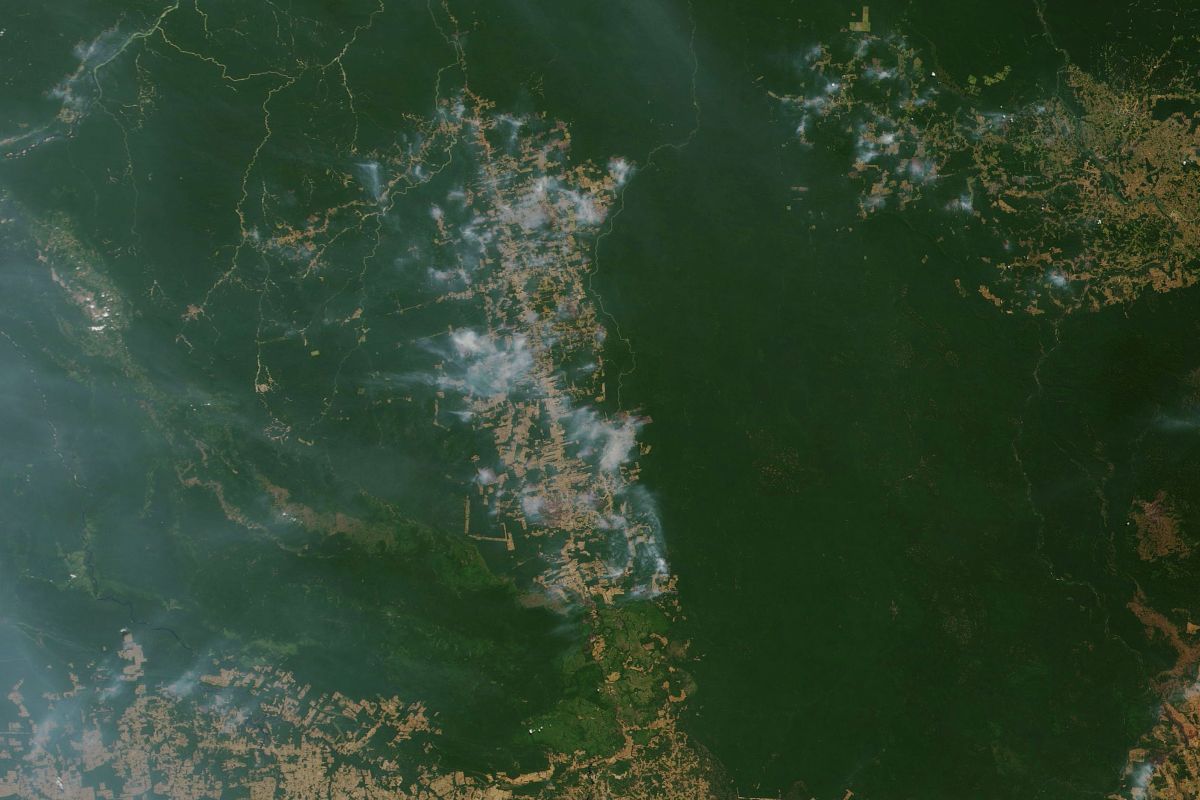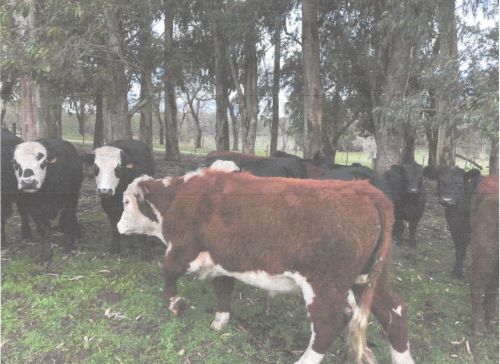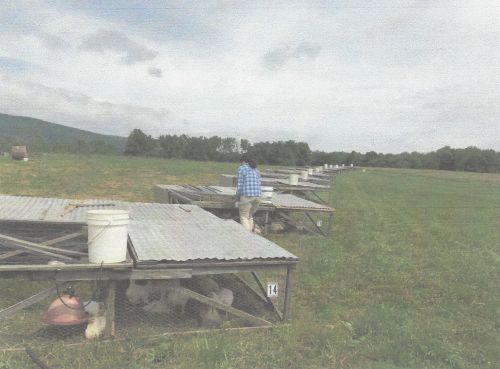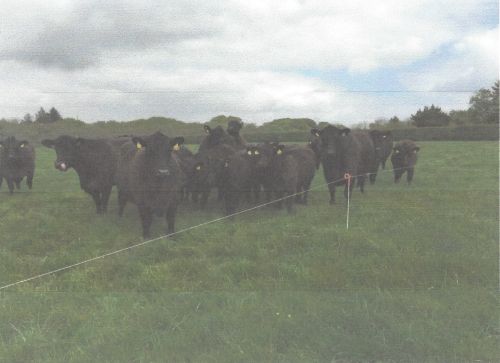Conclusions
To increase the incentive to produce eat in a sustainable way will require customers who insist on sustainable practices. There are many practices that are sustainable when they are done in moderation, but they quickly become non-sustainable when overloaded. Some examples would be grazing, timber production, biofuel production, fishing, and monoculture for either producing feed for livestock or producing palm oil. Traceability through the supply chain is essential.References
Amigo, I. (2020) The Amazon's fragile future, Nature, 578, 505-507.Apuzza, M., Gebekidan, S., Armendartz, A. and Wu, J. (2019) Growing at Europe's Subsidized Farms: Pollution, New York Times, December 26,2019, p. A1.
Asai, M., Moraine, M., Ryschawy, J., deWit, J., Horhide, A.K.,and Guillaume, M. (2018) Critical factors for crop-livestock integration beyond the farm levels: A cross analysis of worldwide core studies, Land Use Policy, 73, 184-194.
Basset, V. and Lamarre, G.P.A. (2019) Toward a world that values insects, Science 264, 1230-1231.
Bates, M. (2019) New record for U.S. ethanol production and exports in 2018, Iowa Farm Business.
Boijs, S., Amp, B., Tuyttens, F.A.M. (2017) Sensitivity of welfare quality broiler chicken protocol to differences between intensively reared indoors flocks which factors explain overall classification? Animal, 11, 244-253.
Bomgardner, M. (2019) A most troublesome weed, Chemical and Engineering News, August 5, 2019, p.25.
Bonaudo, T., Bendahan, A.B., Sabatier, R., Ryschawny, J. Bellon,S., Leger, F., Magdes, D., and Tichit, M. (2014) Agroecological principles for the redesign of integrated crop livestock systems, European Journal of Agronomy 57,43-51.
Borer, E.T., Sea bloom, E.W., and Yang, L.H. (2014) Herbivores and nutrients control grassland plant diversity via light limitation, Nature, 508(7497), 517-520. Doi:l0.l038/nature13144.
Bourzack, K. (2017) Cleaning up nitrogen on farmlands, Chemical and Engineering News, April, 2017, pp. 16.
Broom, D.M. (2019) Animal welfare complementing or conflicting with other sustainability issues, Applied Animal Behavior Science 219, 104829, doi.org/l0.l016/j.applanim.2019.06.010.
Buller, H., Blokhuis, H., Jensen, P. and Keeling, L. (2018) Towards farm animal welfare and sustainability, Animals 8(6): 81 doi:l0.390/ani806008l.
Burgess, M.G., McDermott, G.R., Owashi, B., and Peavey-Reeves, L.E. et al, (2018) Protecting marine mammals, turtles, and birds by rebuilding global fisheries, Science, 359, 1255-1258.
Capper, J.L. (2013) Should we reject animal source foods to save the planet? A review of sustainability of global livestock production, South African Journal of Animal Science, 43(3).
Capper, J.L., and Cady, R.A. (2020) The effects of improved performance in the U.S. dairy cattle industry on environmental impacts between 2007 and 2017. Journal of Animal Science 98, doi.org/10.1093/jas/sksz291.
Carlson, K.M, Gerber, J.S., Mueller, N.D., Herrero, M. et al. (2016) Greenhouse emissions intensity of global croplands, Nature Climate Change, 7, 63-68 (2017).
Carvalho, N., Luis, J., Guilherme-Silva, R., Leidivan-Almeida, F., Cerri, C.E.P., Bernoux, M. and Cerri, c.c. (2014) Crop-pasture rotation: A strategy to reduce soil greenhouse gas emissions in Brazilian Cerrada. Agric. Ecosyst. Environ., 183, 167-176. Doi.l0.l016/j.agee.2013.11.014.
Carvalho, P.C.F., Peterson, C.A>, Nunes, P.A.A., Martins, A.P. et al. (2018) Animal production and soil characteristics from integrated crop livestock systems: Towards sustainable intensification, Journal of Animal Science, 96, 3513-3525.
Casanova, L.M., Hill, V.R., and Sobsey, M.D. (2019) Antibiotic resistant salmonella in swine wastes and farm surface waters, Letters in Applied Microbiology doi.l0.1111/lam.13242.
Chaudhuri, S. (2019) World faces trash glut after China ban, Wall Street Journal, December 20, 2019, p. A1-A11.
Chen, R.C, Williams, J., Beatre, G.A., and Liebman, M. (2018) Cropping system diversification reduces severity of sudden death syndrome caused by Fusarium, American Phytopathological Society doi.orgjl0.l094/PD15-11-16-1660-RE.
Chen, W., Huang, D., Liu, N., Zhang, Y Badgery, W.B., Wang, X and Shen, Y. (2015) Improved grazing management may increase soil carbon sequestration in temperate steppe. Scientific Reports 5, Article 10892. Doi:l0.l038/srepl0892.
Ciambrone, D.F. (2018) Environmental Life Cycle Analysis, Taylor and Francis, Abingdon, United Kingdom.
Cook, R. (2017) Livestock are part of the biodiversity discussion, Roberts Noble Foundation, Western Livestock Journal, September 11, 2017, Ardmore, Oklahoma, USA.
Dasi, T., Selvaraj, K., Pullakhandam, R. and Kulkarn, B. (2019) Animal source foods for the alleviation of double burden of malnutrition in countries undergoing nutrition transition, Animal Frontiers 9(4), 32-38.
deGouw, J.A., Veefkind, J.P., Roosenbrand, E., Dix, B., Lin, J.C, Landgraf, J. and Levelt, P.E. (2020) Daily satellite observations of methane from oil and gas production regions in the United States, Scientific Reports (Nature) 10(1) doi:l0.1038/S41598-020-57678-4.
deGraaf, I.E.M., Gleeson, T., (Rens) Van Beek, L.P.H., Sutanudjaya, and Bierkens, M.F.P. (2019) Environmental flow limits to global groundwater pumping, Nature 574:90-94 (use groundwater flow to streams).
deGraaf,S., Ampe, B., Einkler, M., Mourier, R.L., Kirchner, M.K, and Haskell, M.J. (2017) Trained user opinion about welfare quality measures and integrated scoring of dairy cattle welfare, Journal of Dairy Science, 100 (8) 6376-6388.
DeVries, M. (2013) Evaluating results of the Welfare Quality multi-criteria evaluation model for classificsation of dairy cattle welfare at the herd level, Journal of Dairy Sciences.
Dobrowclski, J. and Engle, D.M. (2016) Future directions of usable science for sustainable rangelands: Water, Rangelands, 38{2}, 68-74. Doi:l0.1016/j.rala.2016.01.004.
Earth Observatory (2015) What is behind rising levels of methane in the atmosphere, earthobservatory.nasa.gov (accessed November 10, 2019).
Economist (2020) The methane hunters, The Economist, February 1, 2020, pp. 69-70.
eia (2011) Emissions of greenhouse gasses, U.S. Energy Information Administration, eia.gov (accessed November 10, 2019).
Eisler, M.C., Lee, M.R.F. et al, (2019) Steps to sustainable livestock, Nature.com (accessed December 16, 2019).
Elbein, S. (2019) Europe's renewable energy policy is built on burning American trees, (accessed Dec. 21, 2019).
Elliot, R. (2019) The leaks that threaten the clean image of natural gas, Wall Street Journal, August 10, 2019, p. 86.
Epa.gov (2019) Environmental Protection Agency (accessed January 31,2020).
Epp, M. (2018) Is slow growth broiler production sustainable? Canadian Poultry, October 14, 2018,. (accessed January 5, 2020).
ESA (2020) Airborne nitrogen oxide plummets over China, European Space Agency, ESA Satellite, earthobservatory.nasa.gov (accessed April 9, 2020).
European Parliament (2017) Food waste: The problem in the EU in numbers, Europarl.europa.cu (accessed, December 7, 2019).
FAO (2006) Livestock Long Shadow, Food and Agriculture Organization, United Nations, Rome 2006.
Ferrante, L. and Fearnside, P.N. (2020) Brazil's biofuel plans drive deforestation, National Institute of Amazonian Research (INPA) Nature, 577, 170.
Fletcher, S.E.M. and Schaefer, H. (2019) Rising methane: A new climate challenge, Science 364:932-933.
Frazluebbers, A.J. (2007) Integrated crop livestock systems in the Southeastern USA, Agronomy Journal, 99, 361-372.
Garnett, T., Appleby, M.C., Balmford, A., Bateman, !.J., Benton, T.G., Bloomer, P., Burlingame, S., Dawkins, M., Dolan, L., Fraser, D., Herrero, M., Hoffmann, I., Smith, P., Thornton, P.K., Toulmin, c., Vermeulen, S.J. and Godfray, H.C. (2013). Sustainable intensification in agriculture: Premises and policies, Science, 341 (6141): 33-34. Doi:l0.1126/science.1234485.
Gaspavatos, A., Stromberg, P., and Takeuchi, K. (2013) Sustainability impacts of first generation biofuels, Animal Frontiers 3(2) doi:l0.2527/af-20B-00ll.
Gibbons, S. (2019) Massive 8,000 mile dead zone could be one ofthe Gulfs largest, National Geographic, June 10, 2019.
Goodchild, M. (2015) Converting planted pine to silvopasture benefits cattle and timber, University of Florida, IFAS Extension, Gainesville, Florida.
Goodwin, J. (2019) Top 10 common grazing management misconceptions, Noble Research Institute, Western Livestock Journal, June 3, 2019.
Grandin, T. (2019) Thoughts on using animals for food, Journal of Applied Animal Ethics Research, 1:35-40.
Grandin, T. and Whiting, M. (2018) Are we Pushing Animals to Their Biological Limits? CABI Publishing, Wallingford, Oxfordshire, UK.
Grossi, G., Goglio, P., Vitali, A. and Williams, G. (2017) Livestock and climate change: Impact of livestock on climate and mitigation strategies, Animal Frontiers 9(1):69-76.
Harrington, T. (2015) European renewable energy is destroying U.S. forests, Business Insider, Dec. 23, 2015.
Hayek, M.N and Garrett, R.D. (2019) Nationwide shift to grassfed beef requires larger cattle population, Environmental Research Letters, 13{8) 084005.
Hefferman, O. (2019) Deep Sea Dilemma, Nature 571,465-468. (mineral mining the ocean floor cause extinctions).
Hendershot, J.N., Smith, J.R., Anderson, C.B., Letten, A.D., Frishkoff, L.O., Zook, J.R., Fukami, T., and Daily, G.c. (2020) Intensive farming drives long-term shifts in avian community composition, Nature, 579, 393-396.
Heyman, S. (2020) The Planter of Modern Life: Louis Bromfield and the Seeds of a Food Revolution, W.W. Norton, New York, NY.
Hogue, C. (2019) U.S. cities leak much methane, Chemical and Engineering News, American Chemical Society, July 29,2019, p. 15.
Huntsberger, L. (2019) Livestock grazing helps California tackle wildfire, University of California, Cooperative Extension, Western Livestock Journal, Feb. 4, 2019.
Iannotti, L.L. (2018) The benefits of animal products for child nutrition in developing countries, In: T. Grandin (Editor) Scientific and Technical Review, The Contribution of Animals to Human Welfare, OIE, World Organization for Animal Health, Paris, France, pp. 37-41.
Jacobs, A. (2019) Nothing to Snort At, Science Times, New York Times, p. Dl, December 10, 2019.
Jiang, Y., Oian, H., Huang,S., Zhang, X. et al. (2019) Acclimation of methane emissions from rice paddy fields to straw addition, Science Advances 5(1) eeau 9038 doi:10.1126/sciadv.aau.9038.
Jose, S. and Dollinger, J. (2019) Silvopasture: A sustainable livestock production system, Agroforest Systems, 93, 1-9.
Karavolias, J., Salois, M.J., Baker, K.T., and Watkins, K. (2018) Raised without antibiotics: Impact on animal welfare and implications for food policy. Translational Animal Science 2:337-348.
Knight, S. (2020) Annals of Nature, Betting the Farm, The New Yorker, February 17, 2020, pp, 32-38.
Kratli, S., Huelsebusch, c., Brooks,S., and Kaufmann, B. (2013) Pastoralism: A critical asset for food security under global climate change, Animal Frontiers doi:10.2527/af.2013-0007.
Krupinsky, J.M., Bailey, K.L., McMullen, M.P., Gossen, B.D., and Turkington, R.K. (2002) Managing plant disease risk in diversified cropping systems, Agronomy Journal 94, 198-209.
Lai, R. (2017) Research and development priorities in water security, Agronomy J., 107{4):1567-1572.
Lemaire, G., Franzluebbers, A., Carvalho, P.C.F. and Dedieu, B. (2014) Integrated crop livestock systems: Strategies to achieve synergy between agricultural production and environmental quality, Agric. Ecosyst. Environ. 190:4-8, Doi:10.1016/j.agee.2013.08.009.
Lindquist, B., Groenigen, K.J., Adviento-Borbe, M.A., Pittelkow, c. and vanKessel, C. (2011) An agronomic assembly of greenhouse gas emissions from major cereal crops, Global Change Biology 18(1) doi.org/10.1111/j.1365-2486.
l.iu, N., Zhang, Y., Change,S., Kan, H., and Lin, L. (2012) Impact of grazing on soil carbon and microbial biomass in typical steppe and desert steppe of Inner Mongolia, PLOS One, doi:10.1371/journal.pone 0036434.
l.upo, L. (2019) The Impossible Burger, the non-meat for meat lovers, Quality Assurance and Food Safety, September/October, pp. 16-23.
Margan, Cd. et al. (2017) Perception of Agricultural and Corporate Social Responsibility, Journal of Food Product Marketing, 24(2)146-162.
Marty, J.T. (2015) Loss of biodiversity and hydrologic function in seasonal wetlands persists over 10 years of livestock grazing removal, Restoration Biology, 23(5),548-554. Doi:10.1111/rec.12226.
McGee, C. (2019) Wood pellets draw fire as an alternative to coat Wall Street Journal, August 7, 2019.
McGrath, M. (2017) Most wood energy schemes are a disaster for climate change, Science and Environment .1 Feb. 23, 2017.
McKibben, B. (2020) What will the new normal look like after the Corona virus pandemic (Interview) 60 Minutes, CBS New York. (Accessed May 17, 2020).
McLaughlin, K. (2019) Saving the Steppes, Science 363:446-447.
McSherry, M.E. and Richie, M.E. (2013) Effects of grazing on grassland carbon, A Global Review, Global Change Biology, 19, 1347-1357.
Mikwanazi, M.V., Ncobela, C.N., Kanengoni, A.T. and Chimonyo, M. (2019) Effects of environmental enrichment on the behavior physiology and performance of pigs: A Review Asian-Australasian Journal of Animal Sciences, 32, 1-13.
Mitloehner, F. (2019) Testimony before the Committee on Agriculture, Nutrition, and Forestry, U.S. Senate.
Monosson, E. (2019) Fungicides sterilize the soil. Berry Blues, Science 365, 647-528.
Montgomery, D. (2020) The Novelist Who Loved Soil, Nature 580, 319-320.
Moraes, A., Carvalho, P.C.F., Lustosa, S.B.C., Lang, C.R. and Deiss, L. (2014) Research on integrated crop livestock systems in Brazil, Rev. Cien. Agronom, 45(5) doi:10.1590/51806-66902014000500018.
Mulhollern, J. (2015) Boosting milk production efficiency can reduce cow methane-emission intensity, Penn State University, University Park, PA.
Mullen, R. (2020) A Turning Point for Pharmaceuticals, Chemical and Engineering News, April 21,2020,pp.30-35.
NASA (2019) Uptick in Amazon Fire Activity in 2019, EOS Project Science Office, NASA Gooddard Space Flight Center, (Accessed January 5,2020).
Nunes, M.R., Mathjs, H., Schindelbeck, R., Ristow, A.M. and Ryan, M. (2018) No-till cropping system diversification improve soil health and crop yield, Geoderma, doi.org/10.1016/j.geoderma.2018.04.31.
Paletto, A., Verardi, S., Pieratti, E., Teston, F., and Romagnoli, M. (2019) Assessment of environmental impacts of biomass power plant to increase the social acceptance or renewable energy technologies, Heliyon 5(7) e02070 doi:10.1016/jheliyon.2019.e02070.
Papanastasis, V.P. (2009) Restoration of degraded grazing lands through grazing management: Can it work? Restoration Ecology, 17(4}:441-445. Doi.10.1111/j.1526-100X.2009.00567.x.
Pathak, S. (2020) With Corona Virus lockdown, India's cities see blue skies on air pollution drops, www.npr.org, April 10, 2020 (accessed April 11, 2020).
Pennisi, E. (2019) Billions of North American birds have vanished, Science 365:1228-1239.
Place, S.E. and Mitloehner, M. (2014) The Nexas of Environmental Quality and Livestock Welfare, Annual Review of Animal Bioscience, 2:1-15.
Pornar, C. and Remus, A. (2019) Precision pig feeding: A breakthrough toward sustainability, Animal Frontiers, 9:52-59.
Powles, S.B. (2008) Evolved glyphosate resistant weeds around the world: Lessons to be learned, Pest Management Sciences, doi:10.1002/ps1525.
Quin, A. and Hodges, J. (2019) Your bowl of rice may be hurting the climate too, Bloomburg, June 3, 2019.
Rausch, L.c., Gibbs, H.K. Schelly, I. et al. (2019) Soy expansion in Brazil's Cerrado, Conservation Letters 12(6) doi.org/10.1111/conl.12671.
Reisinger, A. and Clark, H. (2017) How much do direct livestock emissions actually contribute to global warming? Global Change Biology 2018:24:1749-1761.
Rezaei, M., Yaguesson, J., Gunnarsson, 5., Jonsson, L. and Wallenbeck, A. (2018) Feed efficiency growth performance and carcass characteristics of a fast and a slower growing broiler hybrid fed low and high protein organic diets, Organic Agriculture, 8, 121-128.
Richey, A.S., Thomas, B.F., Lo, M.H., Reager, 1T., Famiglietti, 1S., Voss, K., Swenson, S. and Rodell, M. (2013) Quantifying renewable groundwater stress with GRACE, Water Resource Research 51(7):5217-5238, doi:10:1002/2015WR017349.
Richey, A.S., Thomas, B.F., Lo, M.H., Famiglietti, J.S., Swenson, S. and Rodell, M. (2015) Uncertainty in global groundwater storage estimates in a total Groundwater Stress Framework, Water Resour. Res. 51{7}:5198-5216 doi:10.1002/2015WR017351.
Roche, L.N., Schohr, T.K., Derner, J.D., Lubell, M.N., Cutts, B.B. et al. (2015) Sustaining working rangelands, Insights from rancher decision making, Rangeland Ecology and Management 68, 383-389.
Roos, R. (2020) Experts say COVID19 will likely lead to US. Drug shortages, CIDRAP, Center for Infectious Disease Research and Policy, University of Minnesota.
Rubenstein, M. (2012) Emissions from the cement industry, State of the Planet, Earth Institute, Columbia, University.
Ruen, J. (2014) Cellulosic ethanol plants coming online, Ag Professional, ARA-NACC, September 2014, p. 28-29.
Russell, M.P., Entz, M.H., and Franzluebbers, A.J. (2007) Reconsidering integrated crop livestock systems in North America, Agronomy Journal, 99, 325-334.
Salter, A.M. (2018) The effects of meat consumption on global health, In: T. Grandin (Editor) Scientific and Technical Review, The Contribution of Animals to Human Welfare, OIE, World Organization for Animal Health, Paris, France, pp. 47-51.
Samuel, B.A., Igboama, M.C., and OtrfacIe, 1.1. (2019) Impact of integrated fish farming on antimicrobial resistant bacteria in pond environments, Nigerian International Journal Current Microbiology and Applied Sciences, doi.org/10.20546/ijams.2019.809:281.
Sandy, M. and Bandeirantes, U. (2019) The tipping point, Time, September 23,2019, p. 68-85.
SARE (2019) The Philosophy and Practices of Sustainable Agriculture, Sustainable Agriculture Research and Education Program, University of California Davis, California.
Scherer, L., Tomasik, B., Rueda, 0., and Pfister, S. (2018) Framework of integrating animal welfare into life cycle sustainability assessment, International Journal of Life Cycle Assessment, 23: 1476-1490.
Sengupta, S. and Cai, W. (2019) Water crises may grip a quarter of humanity, New York Times, August 7,2019, p, A6 Arid parts of Western U.S., Mexico, Middle East and India Water Shortage)
Servick, K. (2014) Eavesdropping on Ecosystems, Science 343:834-837. (Monitoring sound to monitor, insects, birds).
Soussana, J.F., and Lemaire, G. (2014) Coupling carbon and nitrogen cycles for environmentally sustainable intensification of grassland and crop systems, Agriculture Ecosystems and Environment, 190,9-17.
Spencer, T.E. (2013) Early pregnancy concepts, challenges and potential solutions, Animal Frontiers 3, 48-55.
Springmann, M., Clark, M., Matson-D'Croz, D., Weibel K. et al. (2018) Options for keeping the food system within environmental limits, Nature 562:519-525.
Sterling, T. and Meijer, B. (2019) Netherlands cuts speed limit to reduce nitrogen, Reuters Sustainable Business, Nov. 13, 2019.
Stokstad, E. (2019) Nitrogen crisis threatens Dutch environment and economy, Science 366:1180-1181.
Stokstad, E. (2020) United Kingdom breaks from EU farm subsidies, Science 367 (6476), 348-349.
Taylor, R. and Nel (2014) When Wells Run Dry, Nature 516, 179-180, (irrigation 70% global fresh water withdrawal).
Teague, R., Provenza, F., Kreuter, V., Steffens, T. and Barnes, M. (2013) Multipaddock grazing rangelands: Why the perceptual dichotomy between research results and rancher experience, Journal of Environmental Management, 128, 699-717.
Thomas, D. (2019) Fashionopolis, Penguin Press (Random House), New York, NY.
Thornton, G. (2016) The expanding market for slow growing broilers, Watt Poultry, USA, October pp. 23-28.
Tilman, D., Cassman, K.G., Manson, P.A., Naylor, R., and Polasky, S. (2002) Review article: Agricultural sustainability and intensive production practices, Nature, 418:671-677.
Tollefson, J. (2020) Can a rainforest be destroyed by gold mining bounce back? Nature 578, 202-203.
Tonucci, R.G., Nair, R.K., Garcia, R. and Bernardino, F.S. (2011) Soil carbon storage in silvopasture and related land use systems in Brazilian Cerrado, Journal of Environmental Quality, 40, 833-841.
Topping, CL, Aldrich, A. and Berny, P. (2020) Overhaul environmental risk assessment of pesticides, Science 367(6476), 360-363.
USDA (2016) How much food waste is there in the United States?
USDA Agricultural Economic Research Service (2019) Corn production and portion used for fuel ethanol, afdc.energy/gov/data/l0339 (accessed Dec. 21, 2019).
USDA Natural Resources and Conservation Service (2007) Soil and Water Issues related to corn grain ethanol production in Wisconsin, Madison, Wisconsin.
USDA (2019) Since 1970, increasing cattle weights have fueled growth of U.S. beef production as cattle use had decreased, www.erc.usda-gov.
Van Boeckel, T.P./, Pires, J., Silverster, R., Zhao, C. et al, (2019) Global resistance in antimicrobial resistance and animals in low and middle income countries, Science, 365:126.
Van Grimsven, H.J.M., Tiktak, A. and Rougoor, C.W. (2016) Evaluation of the Dutch implementation of the nitrates directives - the water framework directive and national emissions directive, NJAS, Wageningen, Journal of Life Sciences, 78:69-84.
Van Wagenburg, C.P.A., de Haas, V., Hogeveen, H., and VanKerimpen, M.M. (2017) Animal Board Invited Review: Comparing conventional and organic livestock production systems on different aspects of sustainabilitv, Animal 11:1839-1851.
Varijakshapanicker, P., McKune, S., Miller, L., Hendricka, 5., Balehegn, M., Dahl, G.E., NS Adesogen, A.T. (2019) Sustainable livestock to improve human nutrition and economic status, Animal Frontiers, 9{4), 39-50.
Varon, D.J., McKeever, J., Jervis, D., Maasakkers, J.D., Pandlv, 5., Houweling, 5., Aben, I., Scarpelli, T. and Jacob, D.J. (2019) Satellite discovery of anomalously large methane point sources from oil/gas production, Geophysical Research Letters 46(22).
Veysset, P., Lherm, M., Bebin, D., and Roulene, M. (2014) Mixed crop livestock farming systems A sustainable way to produce beef? Commercial farms results, questions, and perspective, Animal 8, 1218-1228.
Voegel, E. (2019) Report EU demand for wood pellets continues to grow, Biomass Magazine, August 5, 2019.
Walt, V. and Meyer, S. (2020) Vicious (Recycle) Fortune, April 2020, pp. 72-84.
Wang, T. (2018) Volume of wood pellet exports by major country 2017, Energy and Environmental Services, Statisa.com (accessed Dec. 21,2019).
Whitman, E. (2019) A Land Without Water, Nature 572:19-21.
Whitworth, K.M. (2017) Gene editing applied to prevention of respiratory porcine reproductive syndrome, Molecular Reproduction Development, doi.10.1002/mrd.22811.
Winfrey, R., Reilly, J.R., Bartomas, I., Carlvean, D.F., Williams, N.M., and Gibbs, J. (2019) Species turnover promotes the importance of bee diversity for crop pollination at regional scales, Science 359:791-793.
Wood Resources International (2019) Over 22 million tons of wood pellets were shipped globally in 2018, prnewswire.com (accessed Dec. 21, 2019).
Xiao-Ming, S.H.!., Gang-Li, X., Tao-Li, c., Zhao, Y.U., Shang, Z.H. and Ma, Q. (2015) Grazing exclusion decrease soil C storage in an Alpine grassland at Qinghai-Tibetan Plateau, Ecological Engineering, 57:183-187. Doi:.1016/j.ecoleng.2613.04.032.
Xic, W.Y., Shen, Q., and Zhau, F.J. (2017) Antibiotics and antibiotic resistance from animal manures to soil: A review, European Journal of Soil Science doi.org/l0.1111/ejss.12494.
Zhou, S.Y.D., Zhu, D., Giles, M., Tang, X.R., Daniell, T., Neilson, R. and Zhu, Y.G. (2019) Phyllosphere of staple crops under pig manure fertilization, a reservoir of antibiotic resistance genes, Environmental Pollution 252:227-235.
Zhu, Y.G., Johnson, T.A., Su, J.Q., Qiao, M., Guo, G.X., Stedtfield, R.D., Hashsham, S.A. and Tiedje, J.M. (2012) Diverse and abundant antibiotic resistance genes in Chinese pig farms, Proceedings of the National Academy of SCience, 110:3435-3440.
List of Figures

Figure 13.2. Silvopasture which is a method for grazing livestock among trees is a sustainable practice when it is done correctly. Conditions can be highly variable and consultation with skilled local people is essential. Photo courtesy Temple Grandin.

Figure 13.3. On Joel Salatin's Polyface Farm - pens with broiler chickens are continually moved to fresh pasture. This method will only work on small-scale operations. In many cases, there are ideas and principles that can be learned in small operations that can be modified and used in larger operations. Photo courtesy Temple Grandin.

Figure 13.4. Irish beef cattle graze on lush green pasture and they are frequently moved. They can be trained so that a single electric string confines them. There is a huge demand for grassfed beef and extremely good management is required to prevent unsustainable practices such as overgrazing. Severe welfare problems can occur if the producer overly restricts a beef cow's access to grass to increase pasture carrying capacity. This can result in severe welfare issues for the cow.

 Click here to return to the Homepage for more information on animal behavior, welfare, and care.
Click here to return to the Homepage for more information on animal behavior, welfare, and care.